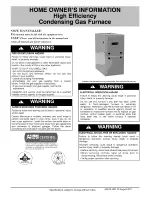
W415-0919 / D / 03.27.13
36
IMPORTANT:
ALWAYS USE A BACKUP WRENCH TO PREvENT TWISTING OF THE GAS vALvE. ANY
STRAINS ON THE GAS vALvE CAN AFFECT POSITIONING OF THE ORIFICES RELATIvE
TO THE BURNERS. THIS COULD RESULT IN FAULTY BURNER OPERATION.
Install a manual gas shut-off valve and dirt pocket as close to the furnace as possible. Some local codes call
for the manual gas shut-off valve to be located between 4 to 5 feet above floor level to prevent tampering by
small children. Ensure that the valve is readily accessible.
IMPORTANT:
ENSURE THAT THE GAS vALvE IS NOT SUBJECTED TO HIGH PRESSURES.
DISCONNECT THE MANUAL SHUT-OFF vALvE AND GAS vALvE DURING ANY
PRESSURE TESTING THAT ExCEEDS ½ P.S.I.G. (3.45 KPA).
WARNINg
!
!
12.3 Gas InleT pRessURe
The natural gas inlet supply pressure should be 5” to 7” w.c. (7” w.c. recommended). The lp gas inlet supply
pressure should be 11” to 13” w.c. (12” w.c. recommended). These pressures must be maintained while all other
gas fired appliances are operating at maximum conditions.
IMPORTANT:
Do NoT ExCEED 13” W.C. INlET pRESSuRE WITh EIThER FuEl.
The gas valve has two adjustable internal regulators for controlling burner manifold pressure. burner manifold
high fire and low fire pressures are listed on the furnace rating plate.
12.4 leaK TesTInG
All new gas piping installations should be pressure tested as specified by CAN/CSA-b149.1 & 2, or NFpA 54
ANSI Z223.1 or ANSI/NFpA 58,
“Standard for the Storage and Handling of Liquefied Petroleum Gases.”
gas piping that has not been pressure tested, from the manual shut-off valve to the furnace gas valve for
example, should be leak tested using an electronic combustible gas detector, a commercially prepared leak
detector, or other locally approved method. A leak detector solution can be prepared by mixing a small quantity
of dish detergent with water and daubing it onto the gas piping, especially the joints.
12.5 pURGInG Gas lInes
NEvER USE A MATCH, TAPER, CIGARETTE LIGHTER, FLAME OR ANY OTHER IGNITION
SOURCE TO CHECK FOR LEAKS IN A GAS LINE.
FAILURE TO ADHERE TO THIS WARNING CAN CAUSE A FIRE OR ExPLOSION
RESULTING IN PROPERTY DAMAGE, PERSONAL INJURY, OR LOSS OF LIFE.
WARNINg
!
!
















































